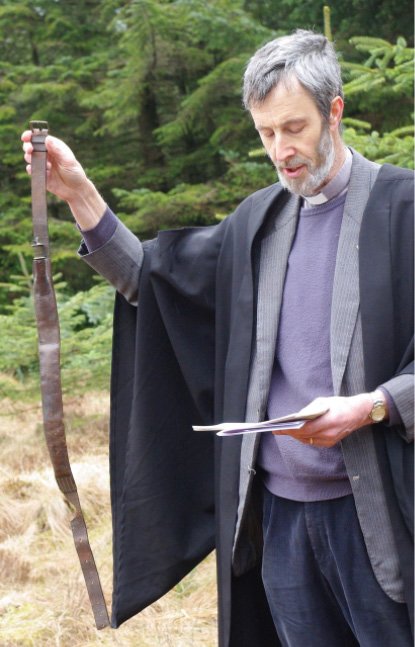The Covenanters of the Glenkens
A review by Andrew Mellor of the book The Covenanters of the Glenkens by David S Bartholomew.
David Bartholomew at the 2013 conventicle near the Palfern Burn photographed by Andrew Mellor
The Reverend Dr. David Bartholomew has written an excellent book that sometimes made me angry - angry at the injustice, intolerance and cruelty it describes rather than because of any shortcomings in authorship, of which there are none. David was the Church of Scotland minister in the Glenkens for 28 years, during which time he carried out extensive research into the history of the seventeenth century Covenanting movement and revived the practice of open-air services or “conventicles.”
In the opening chapter he sets out the complicated seventeenth century historical context. Politics and religion came together when Charles I declared that he was the head of the church in Scotland and that henceforth a new prayer book, which Scottish presbyterians believed echoed Catholic practices, should be used in churches. This was resisted and led, in 1638, to the adoption in churches across Scotland of a Covenant pledging to defend the presbyterian way of worship. Those who signed the pledge were known as “Covenanters.” Their movement became caught up in some of the events that led up to the English Civil War but it was with the restoration of the monarchy under Charles II that events took a darker turn. People who refused to attend services using the new prayer book were heavily fined, the money being collected by soldiers billeted locally. The Glenkens was particularly hard hit with £9577 Scots taken from poor people in Dalry Parish between 1663 and 1666. The troops brutalised those who could or would not pay, seizing possessions and burning down houses.
The Pentland Rising of 1666, which should really be called “the Glenkens Rising” because it started in Dalry, marked the beginning of a period of serious violence which included “the killing times” when troops stationed in the Glenkens were given free reign to murder, without trial, anyone who refused to renounce the Covenant.
Each of the following chapters in the book is devoted to places in the Glenkens associated with the Covenanters. The human stories behind the memorials to those who fell are told movingly, albeit the sources from which the accounts are taken may be somewhat partial. In the chapter on Balmaghie we read how Grierson of Lag and his men had captured a group of Covenanters. Their leader, John Bell, asked for a few moments to make his peace with God but Lag refused this and shot him at point blank range before signalling his men to kill the other captives as they knelt on the ground trying to pray.
Particularly poignant is the the fact that many of the bodies were left where they fell as a warning to others. Some were recovered, buried and later given memorials by “Old Mortality” but others remained where they lay, unmarked to this day. In 1977 Forestry Commission workers uncovered three bodies by the Palfern Burn near Clatteringshaws. One was a soldier, “recognised by his long military boots.” Nearby two bodies lay together. One was small, likely just a lad. Across his body was a perfectly preserved belt with a brass container, probably intended for gunpowder. No doubt the soldiers had removed anything of value from the bodies but the belt had been left because it had a large nick, perhaps caused by a sword blow. The location of the bodies seems not to have been recorded at the time they were discovered but David managed to find the site and held a conventicle there in 2013 at which psalms were sung, prayers were said and a memorial stone was dedicated.
I hope that David’s wish, expressed in the foreword, that his book will act as a resource to aid the establishment of a covenanting trail, is granted. Until then it stands as a well-researched and readable account of a shameful episode in our history.
Copies of the book are for sale at the CatStrand and Wright's shop in Dalry, selling for £10 each, or can be ordered direct from David by emailing dsbart92@gmail.com or calling 07762 083 703.


